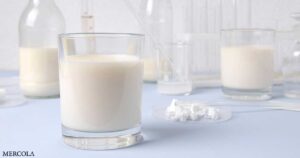Lab-Grown Milk Is Being Fast-Tracked Into Mass Production

Unpasteurized cow’s milk is an incredibly important food. It contains a great mix of fats, carbohydrates, proteins, and other nutrients that support you from birth, all the way into adulthood. Now, biotechnology companies are attempting to cash in by producing fake milk. But as you’ll learn soon enough, it doesn’t hold a candle to the real thing — raw milk from grass fed cows.
Lab-Made Milk Is Being Engineered to Replace the Real Thing
A report published by Investigate Midwest looked into Brown Foods, a biotech startup claiming to have created the world’s first lab-grown milk, dubbed “UnReal Milk.”1
• UnReal Milk is fully lab-grown — Unlike plant-based milk substitutes or fermented dairy analogs, this product is not made from soy, oats, or nuts. Instead, mammalian cells grown in controlled laboratory conditions are coaxed to produce the core nutrients found in cow’s milk. According to Brown Foods, their product mimics real milk at a molecular level and could quickly appear in grocery stores if regulatory approvals are granted.
But don’t be fooled. This isn’t about giving consumers another dairy-free option. It’s about slowly replacing traditional food with synthetic versions that are entirely lab-engineered. In the case of Brown Foods, they’re claiming that UnReal Milk contains the exact same proteins, fats, and carbohydrates that make up 99% of real cow’s milk.
• Fake milk is just the starting point — Brown Foods is not stopping at customers who drink milk. They say their product can also be turned into cheese, butter, and ice cream.
• The company claims the environmental benefits are massive — According to Brown Foods’ data, UnReal Milk uses 90% less water, 95% less land, and emits 82% less carbon than traditional dairy farming.
While those numbers sound impressive at first glance, they aren’t being compared against small, regenerative farms with pasture-raised cows. It’s a comparison against concentrated animal feeding operations (CAFOs),2 which means Brown Foods is intentionally avoiding comparing its product against sustainable dairy operations.
• What’s missing from Brown Foods’ pitch is real-world testing — UnReal Milk is not yet approved by the U.S. Food and Drug Administration (FDA) or the U.S. Department of Agriculture (USDA). There are no long-term studies showing what happens in the body when people consume milk made by lab-grown mammalian cells.
There are no data on digestive effects, allergenicity, hormonal activity, or what’s left behind after processing. Still, the company is pushing hard for consumer tasting events by the end of 2025 and expects to begin market trials as early as 2026.
When a food product is radically new, the lack of transparency should concern you. Brown Foods has released no clinical safety data, no nutritional bioavailability tests, and no allergy risk assessments. They are, however, rolling out the red carpet for venture capitalists, environmental PR campaigns, and lobbying efforts to ease the regulatory burden.
Fake Milk Poses Dangers to Human Health
This isn’t the first time that a company has attempted to introduce fake milk in the market for mass consumption. In 2021, I wrote about Perfect Day, a company that uses genetically engineered (GE) Trichoderma reesei fungus to produce synthetic versions of casein and whey, which are dairy proteins.
• How Perfect Day produces GE whey — The technology doesn’t involve dairy cows, grass, or even sunlight. Just like Brown Foods, Perfect Day places the fungi in sterile tanks. These tanks are “closed systems isolated from the outside world,” according to the company’s own words.3
In plain terms, that means no exposure to natural ecosystems, no relationship to the soil or the land. Just machinery, microbes, and sugar water. The end product is synthetic milk proteins, which are later combined with fats, water, vitamins, and additives to mimic the texture and flavor of real dairy.
• Safety isn’t proven — Even more concerning, Perfect Day’s founders openly admit that their microbes require tightly controlled, artificial environments to function properly. “We can ensure we’re making the purest, safest milk proteins in the world,” the company claims. But how will your body respond to their lab-built proteins? No one knows, because there’s no long-term safety data.
• Perfect Day is also selling the story of sustainability — According to their internal lifecycle analysis, their synthetic whey protein emits 85% to 97% fewer greenhouse gases than traditional dairy production.
But just like Brown Foods, the comparison is made only against factory-farmed dairy systems, not against small-scale regenerative or pasture-raised operations. By ignoring the most sustainable forms of real dairy, the industry paints a misleading picture of what “green” truly means.
• The fake food industry is going after infant formula — In 2022, I also wrote about BIOMILQ, a startup company by Bill Gates, which uses biotechnology to create lab-made human milk for babies. Specifically, the company uses mammary epithelial cells placed in flasks with cell culture media. These cells are then grown in a bioreactor to produce milk.
• Lab-grown food poses dangers to the environment — In February 2021, the Good Food Institute (GFI), a nonprofit group behind the alternative protein industry, released a techno-economic analysis of cultivated meat, which was prepared by consulting firm CE Delft.4
In it, they developed a model to reduce the current costs of cultured meat production down to a point that would make it economically feasible in full-scale plants by 2030, a model they said is “feasible.”
However, GFI’s own analysts conceded regarding the environmental effects. According to a report from The Counter, “GFI’s own life-cycle analysis found that cultivated meat could have worse climate impacts than some forms of chicken and pork if conventional energy is used.”5
• We already have enough food — Farmer and historian John Lewis-Stempel points out that the world’s farmers already produce enough food for the global population. According to his article from UnHerd, “[A]ny discussion of global food policy needs to begin with one plain fact: there is … no actual food shortage. Already, the planet’s farmers produce enough food to cater for the projected 10 billion humans of 2050. The problem is waste and distribution.”6
• A silver lining in the production of fake food — For all the current hype around fake food, there’s a silver lining — the industry is experiencing notable roadblocks. According to a report by The Business Journals, published on February 12, BIOMILQ has filed for bankruptcy. Its technology and assets are stuck in a litigation limbo, giving us a reprieve from the assault of this fake food.7
Raw Milk Trumps Fake Milk
While fake milk startups paint their products as a sustainable alternative, the lack of real-world testing puts their claims in a questionable light. They believe that their products have all fats, but they fall short of full-fat, raw milk because it contains a rare essential fat — pentadecanoic acid, aka C15:0.
C15:0 is an odd-chain saturated fat (OCFA) primarily found in dairy (it’s also present in smaller amounts in certain fish and plants). What’s notable about this OCFA is that it contributes to optimal cellular health. While it isn’t as well-known as other beneficial fats, I believe that C15:0 deserves a special mention — and it reinforces the goodness of raw, grass fed milk.
• Diabetes prevention — A meta-analysis8 of 33 prospective cohort studies found that people with higher C15:0 levels had a lower risk of developing Type 2 diabetes.
• Mitochondrial health — Research found that C15:0 helped repair mitochondrial function and lowered reactive oxygen species production in a dose-dependent u-curve.9
• Weight management — Daily supplementation of C15:0 at a dose of 5 mg per kilo of bodyweight lowered inflammation, glucose and cholesterol levels in obese mice.10
• LA detoxification — Research shows that people diagnosed with Alzheimer’s generally have elevated levels of oxidized linoleic acid metabolites (OXLAMs) in their blood plasma.11 OXLAMs create systemic inflammation and impair mitochondrial function, resulting in ferroptosis — an iron-dependent type of cell death linked to neurodegeneration.12
How does C15:0 fit into this? As it turns out, this fat helps stop the process by displacing linoleic acid from your cell membranes, thereby reducing lipid peroxidation and stabilizing cellular structures before damage occurs. These findings are compiled in a study I wrote, which I will be sharing more about in the near future.
Real Food Is Always the Superior Choice
The introduction of UnReal Milk is only the beginning. What comes next is a reshaping of how dairy, and food more broadly, is created and consumed. Again, the push for these technologies isn’t about adding another option — it’s about replacing what you eat altogether. However, don’t lose hope; you are still in control of what you eat. Here are my recommendations to help you retain your food freedom:
1. Buy from local farms whenever possible — If you’re lucky enough to live near a local farm, this is your best option. When you buy your meat, milk, and cheese directly from small farms, you’re cutting off the lifeline to fake food empires. Farmers markets are a great place to start.
Once you’re there, ask farmers about their practices, like how the animals are raised and what they’re fed. If you’re a parent looking for a clean source of dairy, look for pasture-raised cows.
2. Avoid lab-grown foods in all forms — Skip the mass-produced ice cream, the “animal-free” dairy, and any food product made using genetically engineered fungi or cell cultures. These products aren’t clean and won’t do any good for your health. They’re built in sterile tanks, filled with unknown residues, and classified as “safe” through regulatory loopholes.
If you’re reading labels and see terms like “precision fermentation,” “animal-free whey,” or “recombinant casein,” put it back on the shelf.
3. Get to know your ingredients again — You don’t need biotech formulas when you understand how to nourish your body using real food. Start with the basics — eggs from pasture-raised hens, full-fat dairy from grass fed cows, meat from regeneratively raised animals, and produce grown without chemicals. If you’re someone who’s been eating processed foods, it’s time to simplify and return to real, whole foods.
4. Speak with your dollars, not just your voice — Every dollar you spend is a vote towards the fight against Big Ag and Big Dairy. Stop funding companies that are replacing farmers with patent holders and swapping natural processes with gene editing. Don’t just avoid their products — stop supporting their brands and educate others about the dangers.
Redirect your spending toward farm co-ops, community-supported agriculture (CSA) programs, and regenerative operations.
5. Support food freedom in your community — Pay attention to laws in your state. Florida, Alabama, Arizona, and Tennessee have already taken steps to block lab-grown meat,13 and as noted by Investigate Midwest, Nebraska is set to do the same.
If you’re someone who cares about your right to choose real food, this is the moment to act. Write to your state representatives. Support policies that protect small farms and transparency in food labeling. You don’t need biotech products forced into your kitchen under the disguise of sustainability. Real sustainability lies in regenerative practices that do not make use of any synthetic or artificial, lab-grown techniques.
Frequently Asked Questions (FAQs) About Lab-Grown Milk and Its Safety Concerns
Q: What is UnReal Milk and how is it different from traditional milk?
A: UnReal Milk is a fully lab-grown dairy product created by the biotech startup Brown Foods. Unlike plant-based substitutes made from soy, oats, or nuts, UnReal Milk is produced by mammalian cells grown in lab bioreactors. These cells are designed to replicate the proteins, fats, and carbohydrates found in real cow’s milk at a molecular level.
However, it lacks the connection to natural ecosystems, traditional farming, and certain essential nutrients found in raw, grass fed dairy.
Q: Are lab-grown milk products safe and well-tested?
A: Currently, there is no FDA or USDA approval for UnReal Milk or similar products. These lab-grown alternatives lack long-term human studies on digestive impact, allergenicity, hormonal effects, or nutritional bioavailability. Despite their claims of being molecularly identical to natural milk, their safety has not been clinically validated, raising concerns about their suitability for consumption without transparent testing and oversight.
Q: How do biotech companies justify lab-grown milk, and are the sustainability claims reliable?
A: Companies like Brown Foods and Perfect Day argue that lab-grown dairy products are environmentally superior, citing reductions in water use, land use, and greenhouse gas emissions. However, these claims are based solely on comparisons with conventional factory-farmed dairy, not regenerative or small-scale pasture-based systems. This paints a misleading picture and ignores the benefits of traditional, sustainable farming practices.
Q: What are the health concerns associated with lab-made milk and dairy proteins?
A: Lab-grown dairy relies on genetically engineered organisms and sterile bioreactors, raising concerns about artificial additives, microbial residues, and synthetic processing. The synthetic process also highlights the absence of C15:0, a beneficial fat in real milk shown to support cellular health, mitochondrial function, diabetes prevention, and weight management.
Without real-world data, there’s uncertainty around how lab-engineered milk interacts with the human body long-term.
Q: What actions can consumers take to support real food and resist lab-grown alternatives?
A: Buy local food from regenerative farms, avoid lab-grown products, and support food transparency laws. Consumers are also encouraged to read ingredient labels carefully (watch for terms like “precision fermentation” or “animal-free dairy”), invest in whole, natural foods, and support legislation that defends food freedom and opposes the replacement of natural agriculture with synthetic biotech.





